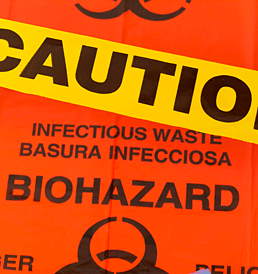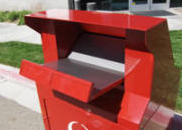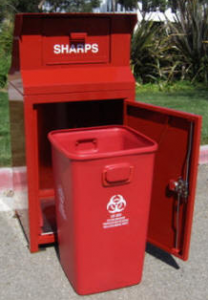 Is the collection and disposal of red bag medical waste costing you more than it should? Proper and effective handling and disposal of “Red Bag” medical waste is not only essential to the safety of patients and staff, but also can save the hospital, nursing home or other medical facility thousands of dollars in unnecessary disposal costs of non bio-hazardous medical waste. At Securr, we understand the needs of medical facilities to properly collect, safely contain and effectively dispose of red bag medical waste, sharps and bio-hazardous material.
Is the collection and disposal of red bag medical waste costing you more than it should? Proper and effective handling and disposal of “Red Bag” medical waste is not only essential to the safety of patients and staff, but also can save the hospital, nursing home or other medical facility thousands of dollars in unnecessary disposal costs of non bio-hazardous medical waste. At Securr, we understand the needs of medical facilities to properly collect, safely contain and effectively dispose of red bag medical waste, sharps and bio-hazardous material.
Many hospitals routinely throw from 50-70% of their waste into the bio-hazardous waste stream, although a large percentage of hospital or medical facility waste is very similar to that of an office building. It consists mostly of paper, cardboard and food waste that does not require Red Bag disposal guidelines. Hospitals often pay up to 10 times as much to dispose of infectious versus solid waste so effective segregation and disposal in proper containers is essential.
Staff Education Regarding Red Bag Medical Waste
Education and understanding of what constitutes hazardous red bag medical waste is the first step in an effective Medical Waste Reduction Plan (MWRP). The Centers for Disease Control (CDC) suggests that only 2-3% of hospital medical waste truly needs to be disposed of as infectious Red Bag hazardous materials. Medical facilities, such as hospitals and nursing homes can save hundreds of thousands of dollars by implementing a comprehensive Medical Waste Reduction Plan and improving their waste segregation and disposal. Case studies have shown that proper education and medical facility policy can realistically decrease red bag waste to a mere 6-10% of their waste stream.
OSHA’s Definition of Regulated Red Bag Medical Waste
Regulated medical waste that requires proper red bag medical waste disposal includes liquid or semi-liquid blood or other potentially infectious materials (defined below); contaminated items that would release blood or other potentially infectious materials in a liquid or semi-liquid state if compressed; items that are caked with dried blood or other potentially infectious materials and are capable of releasing these materials during handling; contaminated sharps; and pathological and microbiological wastes containing blood or other potentially infectious materials.
To learn more about red bag trash and what should be included in a proper Medical Waste Reduction Plan go to www.epa.gov/epaoswer/other/medical/index.htm
How Much Red Bag Medical Waste Are You Generating?
 First you need to understand how much actual red bag medical waste you are generating, the costs of proper handling and disposal. Medical industry guidelines recommend that only 6-15% of your total waste should be going into red bag hazardous medical waste containers.
First you need to understand how much actual red bag medical waste you are generating, the costs of proper handling and disposal. Medical industry guidelines recommend that only 6-15% of your total waste should be going into red bag hazardous medical waste containers.
You need to determine what portion of your waste is currently being disposed of into red bag medical waste containers. This will help you identify how much of an opportunity you have to reduce your volume and your medical waste disposal costs. Work you’re your waste hauling service provider or track invoices to determine if your red bag medical waste disposal costs fall within industry guidelines.
What are Your Red Bag Medical Waste Disposal Costs and Potential Savings?
Understanding your total medical waste disposal costs and your opportunities for cost savings is a powerful tool that needs to be quantified and shared with management and staff. Their involvement will not only reduce costs, savings, but can also improve
employee awareness and morale, improve overall facility safety, along with having a positive impact on the environment and community relations.
Beth Israel Medical Center in New York City, implemented
An Effective Red Bag Medical Waste Segregation Strategy
Proper staff access to both red bag medical waste disposal units, as well as regular waste and trash disposal and recycling systems is the first step in a proper waste segregation strategy and red bag medical waste reduction effort. Provide the proper disposal units for employees to easily implement waste segregation. Once you make it easy for staff to properly segregate waste, you will end up with less misplaced waste in your red bags.
Proper Medical Waste Container Placement and Signage
 Proper container placement and signage is essential to the success of any waste segregation strategy and reduction in your red bag medical waste levels. Work with your nursing and medical support staff to identify the proper placement of your medical waste, trash and recycling receptacles.
Proper container placement and signage is essential to the success of any waste segregation strategy and reduction in your red bag medical waste levels. Work with your nursing and medical support staff to identify the proper placement of your medical waste, trash and recycling receptacles.
Utilizing the proper, specially designed red bag medical waste disposal containers that include the proper signage, bio-hazard label as well as other applicable labeling, provides instructions and on-the-spot education to help reduce solid waste that is casually tossed in my the medical staff out of convenience rather than necesity. Having additional non medical waste collection receptables near by is also important.
Utilizing the Right Medical Waste Collection and Disposal System
The right red bag medical waste collection system is an essential part of any waste segregation and cost saving strategy. The Securr Red Bag Medical Waste collection and disposal system provides your facility with a safe a secure solution to the handling of sharps and medical waste. Securr medical waste disposal receptacles are heavy duty, ADA compliant products that are a great choice where aesthetics and durability are key. Using a “chute” type loading door, contents are secure and cannot be removed unless the service door is unlocked.
Inside the heavy-gauge steel enclosure is a regulated medical waste liner with lid that can be removed and transported safely and securely.
For more information on a Securr Solution to handle red bag medical waste as well as all of your trash and recyclable disposal needs go to www.securr.com